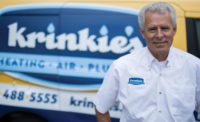Fishing is more fun when there’s a catch on the line. There is nothing worse than casting and reeling, just to feed a lake full of fish the entire bucket of bait. It’s a waste of time and resources, not to mention, it’s frustrating. Unsuccessful marketing efforts can leave contractors feeling much the same as the empty-netted fisherman — exasperated. Effort alone doesn’t cut it; marketing success is dependent on multiple factors.
GOOGLE, GOOGLE, GOOGLE
Most contractors with a web presence have heard the phrase “search engine optimization,” or “SEO.” Despite that fact, some don’t think it has much impact on their businesses. According to Michael Venidis, director of digital marketing at Ryno Strategic Solutions LLC, this sentiment couldn’t be farther from the truth. Ryno works directly with contractors to improve SEO, navigate pay per click (PPC), and create a profitable digital marketing presence.
“The only way someone could technically say that SEO doesn’t matter is if their website is built correctly and properly,” Venidis said. “Google will naturally crawl the website and know that the page exists over time. It’s only going to be able to find it, however, in instances that are exact.”
For example, if a user types in a company name directly, then the website will usually pop up right away and near the top of the page. This creates a false sense of security, according to Venidis, due to the fact that the company can easily be found. SEO, he said, is more strategic than just that.
“People don’t understand that when you do a search on Google, to them it is just one page,” Venidis said. “But on that page, there really is a number of different products that Google offers that are all working together. Simply put, SEO and PPC are probably some of the best marketing channels you can use for any type of local service company right now and in today’s generation — 100 percent. Because you can market to people that are actually interested in your product and services.”
Google Analytics is another integral part of a digital marketing presence, according to Brandon Doyle, marketing manager at Blue Corona.
“Assuming every heating and air conditioning company has a website — and they absolutely should — Google Analytics is a free tool every contractor should install on their website,” he said. “Google Analytics provides data that tells each HVAC contractor how many people are visiting their website, how they arrived on their website — via SEO, PPC, social media sites, etc. — what they’re doing, and so much more. Google Analytics is one of the foundational tools all HVAC contractors should be using.”
The official name of PPC in the Google realm is Google AdWords. This product, along with Local Service Ads by Google, are available to contractors looking to reach specific people who are looking for specific products and services in specific areas.
SOCIAL MEDIA SHIFTS
Talking social media with a 20-year-old includes words like “Instagram” and “Snapchat.” Facebook is the social media platform of their parents’ generation. That doesn’t mean that Facebook is ready to retire to the bench with MySpace just yet, but it does mean that contractors need to be aware of the benefits and shifts of social media marketing. Venidis predicts that the primary social media channel will shift with each generation. The current customers are devout Facebookers in general. The next generation of buyers will likely use Instagram, and after that could come Snapchat.
According to Doyle, Facebook offers marketing tools that empower HVAC contractors to pay to promote their companies to their targeted, desired audiences.
“For example, Facebook Ads allows contractors to serve visual ads to homeowners previously unfamiliar with their company, much like display advertising on Google or Bing,” he said. “Boosted posts take paid advertising on Facebook one step further, allowing HVAC contractors to again target content to homeowners who are likely interested in their services, but with a higher degree of detail than Facebook Ads. Given the fallout from Facebook’s privacy regulations in 2018, our team has actually seen boosted posts perform better than Facebook Ads — generating results that are more cost-efficient, that are seen by a larger audience, and that generate higher engagement.”
Alyssa Young, vice president and director of digital marketing, KickCharge® Creative, said that contractors with Facebook accounts should be posting at least once or twice a week.
“Prospective customers may check out your timeline to vet you, so they want to see that you’re active and engaged,” Young said. “Also, use website click ads with a targeted audience — and monitor the budget to ensure the ad is getting adequate impressions. Installing a Facebook Pixel on your website gives a more complete picture of how people are interacting with posts, ads, and your site.”
Instagram, according to Young, is basically the same as Facebook, but with more visual versus verbal posts.
While Facebook and Instagram provide companies with the tools they need to market their businesses, other companies provide tools to help contractors manage those social media platforms and the content that feeds them.
Sprout social does just that. The social media management platform allows users to create and schedule social media posts across a variety of platforms. According to Doyle, the service provides data and analytics too. Canva is a free do-it-yourself (DIY) tool for HVAC contractors to create visually appealing advertisements.
“Canva is great for contractors looking to enhance the appearance of their imagery on social media platforms,” Doyle said. “It includes everything, from simple features like image cropping to pre-designed templates, image sizing for specific social media platforms, stock imagery to choose from, iconography, and more.”
BROADCAST MARKETING
There are plenty of digital marketing opportunities to be had, but radio and television — better known as broadcast marketing — is another tool that contractors can still use to reach customers. Lauren Smith, marketing coordinator for One Hour Heating & Air Conditioning, Virginia Beach, Virginia, runs what she describes as a mini media agency within the company. Having worked at multiple companies with various clients and mediums, Smith has experience in graphic design, digital marketing, media buying, communications, and more.
“Broadcast, in general, is just a huge benefit for any brand, but especially a brand in home services like HVAC because everyone needs it or everyone knows someone that needs it,” she said.
The company started doing radio spots in 2009 and later started television commercials in 2012. For those interested in becoming involved in radio, television, or both, Smith said to focus on three things: know the budget, manage expectations, and figure out the company message.
Smith explained that knowing the budget is necessary before heading into a meeting to buy media time slots. She has experienced the push of time slot sales. Finding out why the sales person thinks these times are best and holding onto the purse strings can help contractors make the best decisions for their companies’ specific needs.
Managing expectations is especially important in broadcast marketing because the results of radio and television campaigns are different from other marketing tools.
“Broadcast is not like any direct response marketing, like with online or print ads where you are asking customers to call in or do one thing specifically,” Smith explained. “It’s more of a branded message, so it’s going to take a while to really take effect. Plan for the long haul. I’d let it run for at least six months before you try to decide yay or nay.”
Since TV and radio both emphasize branding, hashing out the company message and sticking with it is a must, according to Smith. She also encouraged contractors to set budgets and do their best to stick with it while maintaining professionalism.
“The secret is to get the good production spots,” Smith said. “You want to look buttoned up out there — not like you used Jim’s production studio next door.”
To help stretch the budget, Smith advised that contractors be prepared to use the creation of the production spots, as well as smaller pieces of the spots themselves, in every manner of digital marketing the company is involved with.
“Take behind the scenes pictures while you’re creating your spots,” she urged. “Take the snippets and cut it up to be a little smaller to use in Ad Words for a video ad and for pre-roll. There is just a bunch of different things you can do with just about any media you create from this process. See how many times you can use it over and over again to really get the value out of it.”
Publication date: 4/1/2019
Want more HVAC industry news and information? Join The NEWS on Facebook, Twitter, and LinkedIn today!





